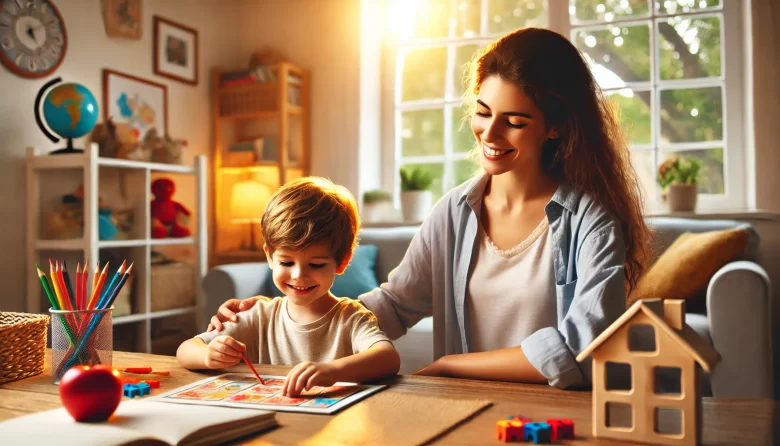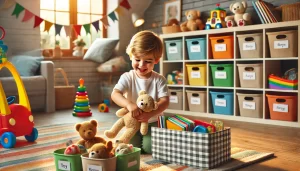Teaching young children at home can be a rewarding experience, but it also comes with challenges—especially when patience starts to wear thin. Whether you’re homeschooling full-time or simply guiding your child’s learning at home, frustration can build up when lessons don’t go as planned, when children lose focus, or when they resist structured learning.
The good news? Patience is a skill that can be strengthened, and teaching at home can be made enjoyable for both you and your child. In this article, we’ll explore practical strategies for maintaining patience, reducing stress, and creating a positive, engaging home-learning environment.
Why Patience Matters in Home Teaching
Patience is essential in a home-learning environment because:
✅ It helps children feel safe and confident while learning.
✅ It prevents frustration and power struggles.
✅ It sets a positive example for children on how to handle challenges.
✅ It allows learning to happen at a natural, child-led pace.
When parents and caregivers approach teaching with patience, children are more likely to stay motivated, curious, and engaged.
Common Challenges That Test Patience
Before diving into solutions, it’s important to recognize what makes home teaching difficult at times. Here are some common frustrations parents face:
Short Attention Spans
Children, especially younger ones, struggle to stay focused for long periods.
Resistance to Learning
Some kids dislike structured activities and may refuse to participate.
Repeating Instructions Multiple Times
It can be frustrating when a child doesn’t seem to listen or remember what you’ve taught.
Balancing Teaching with Other Responsibilities
Many parents juggle household chores, work, and other commitments while teaching at home.
🎯 Pro Tip: Identifying your biggest patience triggers will help you find specific solutions.
Strategies for Staying Patient While Teaching at Home
Adjust Your Expectations
Many parents expect their children to sit still, focus, and follow directions perfectly—but young kids are naturally curious, active, and easily distracted. Instead of forcing traditional classroom-style learning, embrace a more flexible and playful approach.
What to Do Instead:
- Allow for movement and breaks during learning sessions.
- Keep lessons short and engaging.
- Focus on progress rather than perfection.
🎯 Pro Tip: Instead of thinking, “Why won’t they just listen?” try shifting to, “What’s another way I can engage them?”
Use Play as a Teaching Tool
Children learn best through play, so instead of strict lessons, turn learning into an interactive experience.
Examples of Play-Based Learning:
🎲 Use board games to teach math skills.
📚 Act out stories to improve comprehension.
🧩 Incorporate hands-on activities like puzzles and crafts.
🎯 Pro Tip: The more fun your child has, the less resistance you’ll face!
Create a Flexible Routine (Not a Rigid Schedule)
A structured day helps children know what to expect, but too much rigidity can lead to stress for both you and your child.
How to Build a Gentle Routine:
✅ Have consistent learning times but allow for flexibility.
✅ Alternate between structured learning and free play.
✅ Follow your child’s energy levels—schedule focused tasks when they’re most alert.
🎯 Pro Tip: Use visual schedules (pictures instead of words) to help younger children understand daily routines.
Take Breaks When Needed
If frustration starts to build up, it’s okay to take a step back. Breaks help both you and your child reset and return to learning with a better mindset.
Signs That It’s Time for a Break:
❌ Your child is fidgeting, whining, or losing interest.
❌ You feel irritated or impatient.
❌ The lesson is turning into a power struggle.
Break Ideas:
🌳 Take a short walk outside.
🎶 Play a favorite song and have a quick dance break.
🍎 Have a snack together and chat about something fun.
🎯 Pro Tip: A 5-10 minute break can make a big difference in mood and focus.
Practice Deep Breathing and Mindfulness
When you start feeling frustrated, take a deep breath before responding.
Simple Techniques:
🧘♀️ Inhale for 4 seconds, hold for 4 seconds, and exhale for 4 seconds.
💆♂️ Count to 10 before reacting.
🎨 Step away and do something relaxing for a minute (doodle, stretch, or sip tea).
🎯 Pro Tip: Modeling calm behavior teaches children how to manage their own emotions, too.
Encourage Independence in Learning
Giving children some control over their education reduces resistance and helps them develop confidence.
Ways to Promote Independence:
✅ Let them choose between two learning activities.
✅ Give them small responsibilities (e.g., setting up their own workspace).
✅ Allow them to explore topics they’re curious about.
🎯 Pro Tip: When children feel involved in their learning, they are more motivated and cooperative.
Celebrate Small Wins
Focusing on progress instead of perfection helps build patience.
What to Celebrate:
🎉 A child attempting something new, even if they don’t get it right.
🎉 Improvement over time (e.g., better handwriting, longer focus).
🎉 Moments of curiosity and engagement.
🎯 Pro Tip: Keep a “win jar” where you write down small victories and read them together at the end of the week.
How to Make Home Teaching More Enjoyable
Staying patient is easier when learning at home feels like a joyful experience rather than a stressful obligation. Here’s how to make it fun for both you and your child:
Mix Things Up
Try different learning methods to keep things fresh.
✅ Use hands-on activities instead of worksheets.
✅ Learn through storytelling and role-playing.
✅ Take some lessons outdoors for a change of scenery.
Connect Learning to Real Life
Make lessons practical and meaningful.
✅ Use cooking to teach math and measurements.
✅ Write letters or emails to family members to practice writing skills.
✅ Turn grocery shopping into a lesson on budgeting and counting.
Join Learning Communities
Sometimes, teaching at home can feel isolating. Connect with other parents for ideas and support.
✅ Join Facebook groups or online forums for homeschooling parents.
✅ Find local playgroups or co-learning meetups.
✅ Exchange teaching ideas with friends or neighbors.
🎯 Pro Tip: Learning is a shared journey—don’t be afraid to seek support!
Final Thoughts
Patience is not about never getting frustrated—it’s about learning how to manage those frustrations and keep learning enjoyable. By staying flexible, incorporating play, and focusing on small successes, home teaching can become a rewarding and fun experience for both you and your child.
Teaching at home is a journey, not a race. Embrace the process, and remember—every moment of learning together is valuable!




